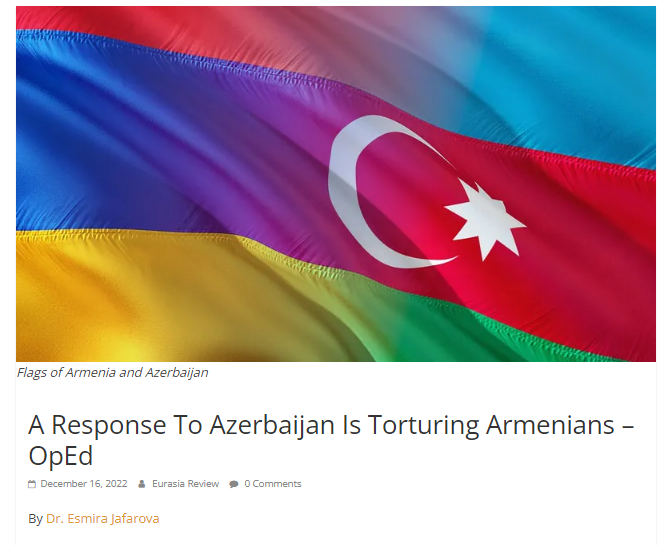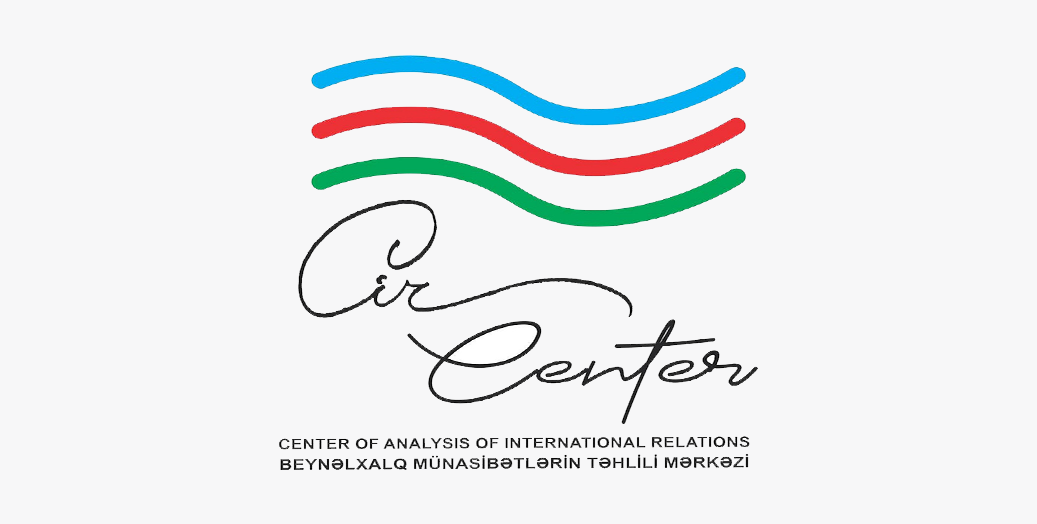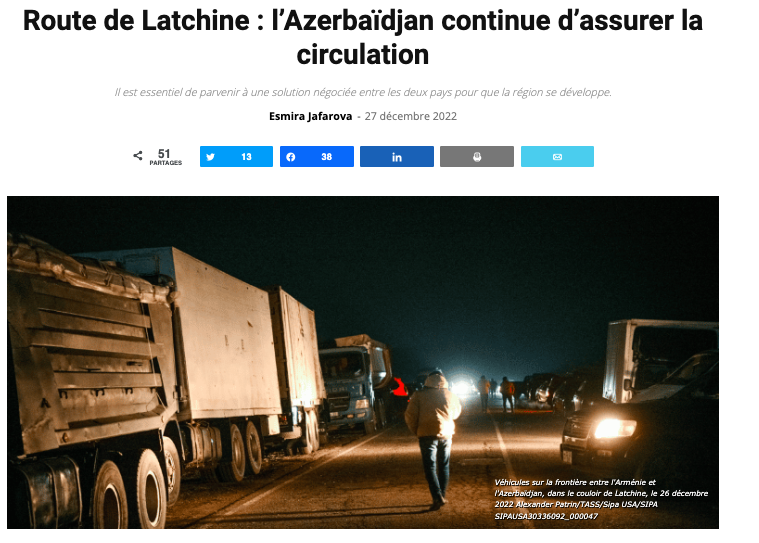This piece is a response to an article in Providence magazine titled “Azerbaijan is torturing and beheading Armenians” by Uzay Bulut, published on December, 5, 2022.
In the article, the author speaks about alleged cases of torture and war crimes committed against Armenians by Azerbaijanis during the 44-Day Karabakh War, and she goes into lengthy detail.
To begin with, one should observe that the author exposes a personal bias in favor of Armenia, the country that kept about 20% of Azerbaijani territories under occupation for nearly three decades, as there was only a single mention of the fact of the occupation. The author’s silence about the four UN Security Council resolutions from 1993 (822, 853, 874, and 884) that called for the immediate, unconditional, and full withdrawal of all occupying forces from the internationally recognized territories of Azerbaijan, should, therefore, also be perceived in this context.
It is clear that the article is very tendentious, which serves the interest of Armenia’s propaganda narrative. Therefore, departing from this premise, several issues about which the author makes wrongful accusations against Azerbaijan need to be highlighted:
First, there are no Armenian prisoners of war (POW) in Azerbaijan, as all of them were returned on the signing of the Trilateral Declaration of November, 10, 2020. Moreover, in exchange for landmine maps, Azerbaijan returned dozens of Armenian detainees. These individuals had been sent by Armenia via the Lachin corridor to conduct disruptive activities in the liberated Azerbaijani territories and were captured by Azerbaijani security forces. Such criminals can therefore not be considered to be POWs. The latest exchange happened on December 5, with Azerbaijan returning ten more Armenian detainees and Armenia passing on minefield maps to Azerbaijan. Nevertheless, and depending on the gravity of their deeds, some of the detainees, including the Lebanese citizen, Vicken Euljekijan, to whom the author refers, are subject to trial and the due course of law. This is a standard practice in every state.
Second, the author also makes false claims that, during the 44-Day War, Azerbaijan was helped by Türkish and the Syrian jihadist mercenaries, an apparent attempt to downplay Azerbaijan’s victory and see more conspiracies where they do not exist. Victory in the 44-Day Karabakh War belongs to Azerbaijan and Azerbaijanis, and the continued attempt on the part of Armenia and its propagandists to ascribe Azerbaijan’s confident victory to external factors simply shows that the lessons of the 44-Day Karabakh War and the pre-war period remain unlearned. Türkiye was not a party to the Armenia–Azerbaijan conflict, including the 44-Day War, and extended only political support to Azerbaijan. Furthermore, both during the 44-Day War and later, Azerbaijan assertively rejected any claims regarding so-called “mercenaries from Syria and Libya.” These claims, alongside other similar allegations, were concocted by Armenia’s propagandists to spread disinformation. Azerbaijan possesses a professional army of about 100 thousand people and therefore does not, and did not, need any external assistance to defend its own lands.
In contrast, there were plausible reports testifying to the instrumentalization of mercenaries and foreign fighters by Armenia during the 44-Day War. Media reports revealed that the Armenian authorities used mercenaries from foreign countries, particularly from Syria and Iraq, to fight against Azerbaijan in Karabakh. Militants from the Kurdistan Workers’ Party (PKK), classified by all Western countries, including the US and the EU, as a terrorist organization, were deployed to the occupied territories to fight against Azerbaijan. Reports also testified to the presence of foreign fighters—citizens of Armenian descent from France, the United States, Greece, Georgia, Lebanon, Syria, Belarus, and other countries—fighting for Armenia during the war. Otherwise, one cannot find a plausible explanation as to what a Lebanese citizen of Armenian origin (read: convicted felon Vicken Euljekijan), whom the author so ardently defends, would be doing in the then-occupied Azerbaijani territories.
Third, the author then lists the alleged cases of torture committed against Armenians during the 44-day Karabakh War, without any reference to the horrendous war crimes committed against peaceful Azerbaijanis during and even before that war. Azerbaijan has made clear that cases of possible war crimes allegedly committed by the Azerbaijani military will be duly investigated. However, no similar pledges have been made or heard from the Armenian side in regard to the war crimes committed against the innocent Azerbaijani population during the First Karabakh War as well as the 44-Day Karabakh War.
Armenia shelled peaceful Azerbaijani cities during the 44-Day Karabakh War in 2020, with Ganja and Barda being among the most affected targets. The second-largest city in Azerbaijani, Ganja was attacked using Tochka-U and, later, SCUD ballistic missiles on October 11, 2020, the very night that a humanitarian ceasefire took effect. Azerbaijan also reported the shelling of cities such as Tartar, Barda, Mingachevir, Aghjabedi, and Beylaghan. However, Ganja became a textbook example of war crimes against peaceful civilians. The missiles used against Ganja were of high destructive capacity and their use against civilians is prohibited under international humanitarian law. These attacks were confirmed as having been launched directly from Armenian territory on October 11 and 16–17, 2020, killing and injuring dozens of civilians as well as causing significant destruction to civilian infrastructure.
According to information distributed by the Prosecutor General’s Office of Azerbaijan, 94 Azerbaijani civilians were killed and 414 wounded as a result of attacks by Armenia from September 27 to November 16, 2020, while about 512 civilian facilities, 3,410 private houses, and 120 apartment buildings were damaged as a result of intensive artillery and missile shelling. Armenia also repeatedly targeted Azerbaijan’s critical energy infrastructure, launching missile attacks against the Baku–Tbilisi–Ceyhan pipeline in the vicinity of Yevlakh district and against Mingachevir city in an effort to strike the Mingachevir Dam and Hydropower Station. Had these attacks succeeded, the magnitude of human casualties as well as the environmental consequences would have been appalling. Indiscriminate attacks against peaceful civilians constitute the gravest violation of international law, international humanitarian and human rights law, and all relevant international instruments, including the Fourth Geneva Convention (1949) and Additional Protocol I (1977).
Azerbaijan has also repeatedly voiced the issue of the fate of approximately 4,000 missing persons. Recently, Armenia declared that it would return to Azerbaijan the remains of 138 Azerbaijanis who went missing during the First Karabakh War; and, in December 2022, Armenia announced that it would return the remains of 10 more people; however, that does not compensate for the long list of people whose whereabouts remain unknown. This picture is further blurred by the discovery of mass graves in the now liberated Azerbaijani lands. In April 2021, the remains of 12 people were found in Bashlibel village of the liberated Kalbajar district, which was another bloody spot where mass murders against peaceful Azerbaijanis were committed in 1993. Later, mass graves were also found in Shusha’s Dashalti village, Khojavand’s Edilli village, Aghdam’s Sirkhavand village, Khojaly’s Farrukh village, and other places. More than 450 bodies, likely belonging to those who went missing during the First Karabakh War, were discovered. Such appalling discoveries speak volumes about the torture and inhumane treatment the Azerbaijanis were subjected to before their actual killing. Who knows how many more such gruesome mass burial places are there underneath the liberated lands?
The Office of the Commissioner of the Human Rights of the Republic of Azerbaijan has distributed several reports testifying to cases of torture, inhumane treatment of Azerbaijanis, child casualties, attacks on civilian settlements by Armenia, landmine threat, as well as other crimes and human rights violations committed against the Azerbaijani population.
Landmine threat is another pressing security issue that constantly threatens civilian lives. According to estimates, the liberated areas of Azerbaijan’s territories are among the most mine contaminated in the world, and the problem is not confined to the magnitude of the contamination, as the accuracy of the minefield maps provided by Armenia was found to be only 25%. Reports suggest that, since the end of hostilities in the fall of 2020, 268 people have been killed or maimed as a result of mine explosions. Recent estimates indicate that clearing of all landmines in the liberated Azerbaijani lands may take up to 30 years and require US$25 billion. War and terror against Azerbaijanis continue every day, and so do war crimes. To date, 3,300 Azerbaijanis are reported to have become the victims of mine blasts from devices planted by Armenia since the First Karabakh War.
Fourth, the author of the abovementioned article makes an attempt to build a faulty link between Azerbaijan’s alleged liability for the crimes cited in the article and its relations with international partners. Azerbaijan’s energy partnership with the countries of the European Union is a two-way street and benefits both sides. Moreover, by providing diversification of sources and routes of energy Azerbaijan has proven itself a reliable partner able to provide not only crude energy, but also energy security to its partners in its immediate neighborhood and in Europe. The memorandum of understanding signed with the European Union in July, 2022, to double the gas export volumes to Europe to meet the continent’s growing energy demand is just another testament to Azerbaijan’s reliability as a business partner. By keeping Azerbaijan’s internationally recognized territories under occupation for thirty years, Armenia self-isolated and deprived itself of a role in the profitable energy and infrastructure projects passing through the region. This should have been the main thesis developed by the author in this context, instead of attacking Azerbaijan for building successful energy partnerships.
Fifth, having provided extensive “details” to substantiate his case, the author, Uzay Bulut, wraps up by suggesting that the international community apply sanctions against Azerbaijan; that the UN Security Council should “demand Azerbaijan unconditionally release all Armenian PoWs and immediately withdraw its forces from the territory of Armenia,” and that the “OSCE deploy peacemakers in the Lachin Corridor to guarantee a secure and safe link between Armenia and Artsakh and deter ongoing Azerbaijani aggression.” To rebuff all these absurd claims in the simplest terms, one has to remind the author and those who are like-minded that, despite illegally occupying Azerbaijani territories, Armenia was never subject to any sanctions from the international community, and the four aforementioned UN Security Council resolutions calling for the liberation of Azerbaijani lands were ignored by Armenia. Also, as argued above, there are no Armenian PoWs in Azerbaijan.
Moreover, the OSCE Minsk Group has lost all credibility, having fallen flat in its attempts to deliver any acceptable and just solution to the conflict during 28 years of mediation activity. It is defunct and will never be back in the same capacity as before. Azerbaijan restored its own territorial integrity and ended Armenia’s aggression and occupation by itself, implemented the four UN Security Council resolutions. And, finally, there is no “ongoing Azerbaijani aggression,” and the use of such language in reference to the liberation of Azerbaijan’s internationally recognized lands is nothing more but a travesty of justice.
Last but not least, the Armenian population in Karabakh are Azerbaijani citizens and their rights are to be provided in accordance with the Constitution and relevant laws of the Republic of Azerbaijan. In the postwar normalization period, Armenia and Azerbaijan are taking baby steps towards the normalization of their relations and this, if successful, could ultimately deliver long-awaited peace and stability for the South Caucasus region. Apparently, these developments trouble certain circles, including in academia. Otherwise, the incendiary article by Uzay Bulut that contains wrongful allegations and disruptive ideas against Azerbaijan is difficult to put into the proper context. One thing is nonetheless clear: henceforth, such futile attempts to throw a wrench into the ongoing peace process cannot stop the tide of positive change toward achieving eventual peace in the region.
https://www.eurasiareview.com/16122022-a-response-to-azerbaijan-is-torturing-armenians-oped/






